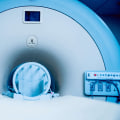When it comes to medical imaging tests, pregnant women have special considerations that must be taken into account. Magnetic resonance imaging (MRI) is similar to ultrasound in the diagnosis of various conditions. There are many reasons why a doctor may recommend that a pregnant woman undergo an imaging exam, such as MRIs, CT scans, X-rays, mammograms, or positron emission tomography. These tests are essential for monitoring, diagnosing, and treating patients, including pregnant women. In most medically appropriate and correctly performed diagnostic tests, the risk of embryos and fetuses is minimal.
However, because of the possibility of greater fetal exposure in computed tomography or radionuclide imaging, pregnant and potentially pregnant women should be identified before radiodiagnostic tests are performed. If necessary, pregnancy tests should be performed. If pregnancy is confirmed or likely, non-ionizing imaging that emits radiation, such as magnetic resonance imaging and ultrasound, should be considered first when clinically appropriate. However, some pregnant women will continue to face the decision to undergo a CT scan or a nuclear medicine imaging diagnosis because the test is clinically justified. In such cases, research should be carefully optimized to minimize the dose for the fetus or infant and still obtain acceptable image quality.
It is also necessary to reduce the anxiety experienced by the mother before and after delivery. Many radiopharmaceuticals are excreted in breast milk. Recommendations for discontinuing breastfeeding should be followed to maintain the effective dose for the infant below 1 mSv. It is very important to permanently discontinue breastfeeding after treatment with all radiopharmaceuticals and also after the diagnostic use of radioactive iodide and radioactive iodine with a high content of free iodide. A pregnant woman is no more sensitive to radiation than a woman who is not pregnant. The risk associated with an imaging procedure for a pregnant woman will be the same for any woman of the same age who is not pregnant (see nuclear medicine).
Before referring a pregnant woman for an imaging test or procedure, the woman's doctor will consult with her and assess that the benefits outweigh the possible risks. Also in this case, the examination can be postponed until breastfeeding has been stopped in an intentional and planned manner, or research can be changed to a method other than nuclear medicine. The Southwest Diagnostic Imaging Center team will always evaluate the risks and benefits of an imaging test for a pregnant woman. However, confusion about the safety of these modalities for pregnant and nursing women and their infants often results in useful diagnostic tests being unnecessarily avoided or breastfeeding unnecessarily interrupted. Most other nuclear medicine diagnostic procedures, except for some SPECT and PET studies, do not cause high fetal doses.
Women of reproductive age who are referred by their doctor for computed tomography (CT), nuclear medicine, angiography, and some simple radiographic tests should inform their doctor and the radiology office if there is any possibility that they may be pregnant. The main advantage of MRI over ultrasound and computed tomography is the ability to obtain images of deep soft tissue structures in a way that is not dependent on the operator and does not use ionizing radiation. Ultrasounds use sound waves to produce images if there is an infection or something that may be causing pain or swelling. The dose varies depending on the gestational age, the physical constitution of the mother, and the imaging parameters. If a pregnant woman undergoes multiple imaging studies with ionizing radiation, it is wise to consult a radiologist to calculate the total dose the fetus receives. Ultrasound should be performed efficiently and only when clinically indicated to minimize the risk of fetal exposure, using the principle of keeping acoustic emission levels as low as reasonably possible (commonly known as ALARA).
The dose absorbed by the fetus in a series of nuclear medicine diagnostic procedures with radiopharmaceuticals other than those labeled with radioactive iodine is shown in Figure 3.If a woman undergoes a radiology or nuclear medicine procedure and later discovers that she is pregnant, it's important to talk to her doctor about the theoretical risks. Like other diagnostic imaging modalities, ultrasonic ultrasound should be used with caution and only when its use is expected to answer a relevant clinical question or provide some medical benefit to the patient (3). However, the potential for risk shows that ultrasound should be used wisely and only when its use is expected to answer a relevant clinical question or provide some medical benefit to the patient (otherwise) 5.






